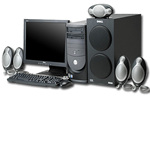Desktops for your business


The basics
Most of the buying decision is a game of specifications, with processor, memory and hard drive size being the most prominent. Don't fall into the trap of paying for too many megahertz. The latest Pentium 4 processors, which boast speeds in excess of 3GHz, are overkill for the vast majority of business applications. In fact, many business users will get by just fine with a slower Celeron chip, even though these (along with AMD processors) tend to be less popular in business. You're better off investing in extra memory and upgrading to 512MB or even 1GB of RAM.
Home PCs need expansive hard drives because they rapidly become cluttered with MP3s, digital photos and home videos. But at work, a standard 20GB drive offers plenty of space for most users. Don't believe us? Look at it this way: you could crank out a new 10MB PowerPoint file every day (we know some managers who have tried), and you'd still have plenty of room after five years.
If you're working with video or large graphics files, however, you'll need a little more muscle in your system. In addition to lots of memory, you'll want a larger hard drive, FireWire and USB 2.0 connectors, and a separate graphics card with its own memory as opposed to one integrated on the motherboard.
Necessary extras
Regardless of the applications you're running, there are a few features you'll want in any business PC. An integrated Ethernet adapter for networks and or cable/DSL connections is a must-have, and you'll be hard-pressed to find a desktop nowadays without one. We also recommend an LCD monitor. These flat panels are increasingly popular because they use only a small amount of desk space, display sharp images, and are easy on the eyes. If your budget doesn't allow it, opt for a good 17in. or 19in. CRT display instead.
If your business needs upwards of 100 desktops, you should consider a managed PC from leading vendors such as HP Compaq, Dell or IBM. Such desktops include several features designed to make them easier and less expensive to deploy and manage. They use similar hardware and software, which lasts for long periods of time, minimising the need to upgrade. The components are designed so that you can swap them out quickly and easily. And they can be monitored and managed remotely using included software. Many managed PCs also come in small form-factor designs -- perfect when space is tight.
Buying advice
As important as what you buy is how you buy it. The PC market changes at a blistering pace, so don't worry too much about model numbers. Instead, buy from a vendor you trust. The best thing you can do when purchasing multiple PCs is buy them all at once and get them from the same vendor (if you can get servers, printers, and displays from the same source, all the better). Even better, purchase identical desktop models. Not only will you get a discount, you'll have interchangeable components when something falls apart down the road.